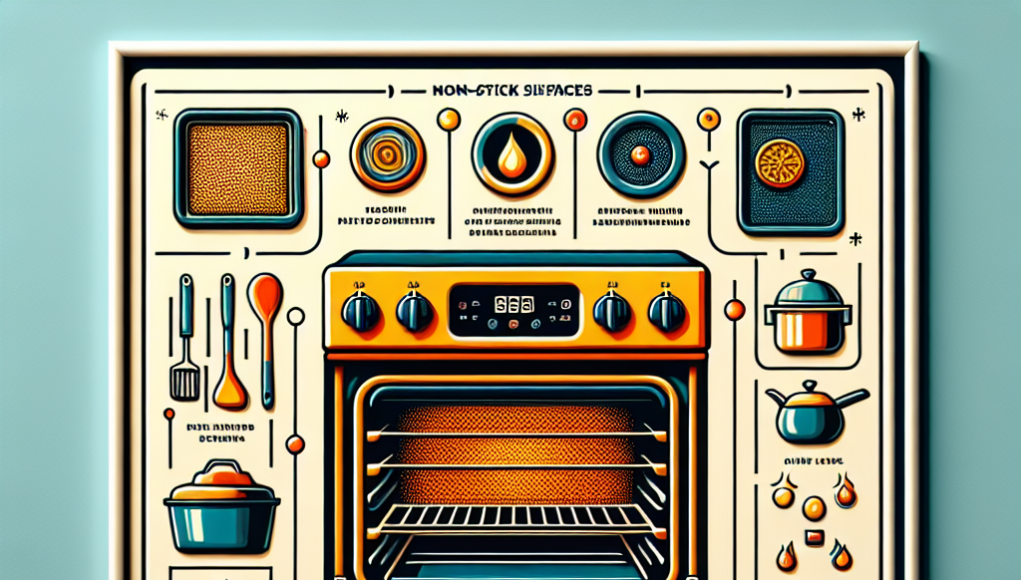Contents
How to Care for Non-Stick Surfaces in the Oven
Non-stick surfaces are a convenient and popular option for baking and cooking in the oven. However, they need to be cared for properly to maintain their effectiveness and longevity. Here are some tips on how to care for non-stick surfaces in the oven:
- Avoid using metal utensils on non-stick surfaces, as they can scratch and damage the coating. Instead, use silicone, plastic, or wooden utensils.
- Do not use non-stick cooking sprays on non-stick surfaces, as they can build up and create a sticky residue that is difficult to remove. Instead, use a small amount of oil or butter to grease the pan before baking.
- Do not use abrasive cleaners or scouring pads on non-stick surfaces, as they can scratch and wear down the coating. Instead, use a soft sponge or cloth with warm, soapy water to clean the surface.
- Avoid cooking foods with high sugar content, as they can cause the non-stick coating to break down and become less effective. Instead, use parchment paper or a silicone baking mat to protect the surface.
By following these tips, you can help extend the life of your non-stick surfaces in the oven and enjoy hassle-free cooking and baking for years to come.
Introduction
Non-stick surfaces in the oven are a great kitchen tool to have, as they make cooking and cleaning much easier. However, it is important to care for them properly to ensure their longevity and effectiveness. In this blog post, we will discuss some tips on how to care for non-stick surfaces in the oven.
Types of Non-Stick Surfaces
Teflon
Teflon is a popular non-stick coating that is commonly used in cookware. It is important to avoid overheating Teflon as it can release harmful fumes. Always follow the manufacturer’s instructions on proper usage and temperature limits.
Ceramic
Ceramic non-stick surfaces are becoming more popular due to their eco-friendly properties. To care for ceramic surfaces, avoid using metal utensils that can scratch the coating. Hand-wash with mild soap and water to prolong its lifespan.
Caring for Non-Stick Surfaces
Avoid High Heat
High heat can cause the non-stick coating to break down over time. Be sure to use the recommended temperature settings on your oven and cookware to prevent damage.
Use Gentle Cleaning Methods
When cleaning non-stick surfaces, avoid harsh scrubbing pads or abrasive cleaners that can scratch the coating. Instead, use a soft sponge or cloth with mild soap and water to gently clean the surface.
Avoid Metal Utensils
Metal utensils can scratch and damage non-stick surfaces. Instead, opt for silicone, plastic, or wooden utensils to protect the coating.
Store Carefully
When storing non-stick cookware in the oven, avoid stacking heavy items on top of them as this can cause dents and scratches. Store them in a cool, dry place to prevent damage.
Conclusion
By following these tips on how to care for non-stick surfaces in the oven, you can prolong the lifespan of your cookware and ensure that it continues to perform effectively. Remember to always follow the manufacturer’s instructions and handle your non-stick surfaces with care.
Click here for more tips on caring for non-stick cookware
Why is it Important to Care for Non-Stick Surfaces?
Non-stick surfaces in your oven can wear out over time if not properly cared for. This can lead to food sticking to the surface, making it difficult to clean and affecting the overall cooking experience. By following these simple tips, you can extend the life of your non-stick surfaces and ensure that your oven continues to function properly.
Cleaning Tips for Non-Stick Surfaces
When cleaning non-stick surfaces in the oven, it is important to avoid using harsh scrubbing tools or abrasive cleaners. Instead, use a soft sponge or cloth to gently wipe away any residue. If there are stubborn stains, you can use a mild dish soap or baking soda paste to help loosen them. Be sure to rinse the surface thoroughly with water after cleaning to remove any residue.
Avoiding Damage to Non-Stick Surfaces
To prevent damage to non-stick surfaces in the oven, avoid using sharp or metal utensils that can scratch the coating. Instead, opt for silicone, wood, or plastic utensils that are gentle on the surface. Additionally, avoid using cooking sprays or oils directly on the non-stick surface, as this can cause buildup and potentially damage the coating over time.
For more information on non-stick surfaces, you can visit Wikipedia.
FAQs: How to Care for Non-Stick Surfaces in the Oven
Q: How should I clean my oven with a non-stick surface?
A: To clean your oven with a non-stick surface, avoid using abrasive cleaners or scrubbing pads. Instead, wipe down the surface with a damp cloth or sponge and a mild dish soap. Make sure to remove any crumbs or spills promptly to prevent buildup.
Q: Can I use cooking sprays on non-stick surfaces in the oven?
A: Avoid using cooking sprays on non-stick surfaces in the oven as they can leave a residue that is difficult to remove. Instead, use parchment paper or silicone baking mats to prevent sticking without damaging the non-stick coating.
Q: How can I prevent scratches on my oven’s non-stick surface?
A: To prevent scratches on your oven’s non-stick surface, avoid using metal utensils or abrasive cleaning tools. Opt for silicone or wooden utensils and gentle cleaning methods to prolong the life of the non-stick coating.
How to Care for Non-Stick Surfaces in the Oven
- Always use non-abrasive utensils on non-stick surfaces to avoid scratching.
- Avoid using cooking sprays or oils on non-stick surfaces as they can build up and create a sticky residue.
- Hand wash non-stick pans with mild soap and water, never put them in the dishwasher.
- Never use metal utensils or abrasive scrubbers on non-stick surfaces.
- Invest in high-quality non-stick cookware to ensure longevity and performance.








































